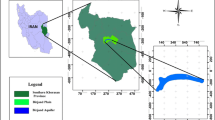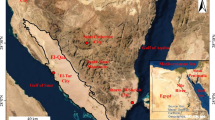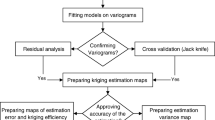Abstract
Groundwater resources are the only source of water in many arid and semi-arid regions. It is important to manage these resources to have a sustainable development. However, there are many factors influencing the accuracy of the results in groundwater modeling. In this research, the uncertainty of two important groundwater model parameters (hydraulic conductivity and specific yield) were considered as the main sources of uncertainty in estimating water level in an unconfined aquifer, in Iran. For this purpose, a simple method called Rosenblueth Point Estimate Method (RPEM) was used to assess groundwater modeling parametric uncertainty, and its performance was compared with Monte Carlo method as a very complicated and time-consuming method. According to calibrated values of hydraulic conductivity and specific yield, several uncertainty intervals were considered to analyze uncertainty. The results showed that the optimum interval for hydraulic conductivity was 40% increase–30% decrease of the calibrated values in both Monte Carlo and RPEM methods. This interval for specific yield was 200% increase–90% decrease of the calibrated values. RPEM showed better performance using the evaluating indices in comparison with Monte Carlo method for both hydraulic conductivity and specific yield with 43% and 17% higher index values, respectively. These results can be used in groundwater management and future prediction of groundwater level.









Similar content being viewed by others
References
Altarejos García, L., Martínez Chenoll, M. L., Escuder Bueno, I., & Serrano Lombillo, A. J. (2012). Assessing the impact of uncertainty on flood risk estimates with reliability analysis using 1-D and 2-D hydraulic models. Hydrology and Earth System Sciences and Discussions, 16(7), 1985–1994.
Bair, E. S., Safreed, C. M., & Stasny, E. A. (1991). A Monte Carlo-based approach for determining traveltime-related capture zones of wells using convex hulls as confidence regions. Groundwater, 29(6), 849–855.
Bogena, H., Kunkel, R., Montzka, C., & Wendland, F. (2005). Uncertainties in the simulation of groundwater recharge at different scales. Advances in Geosciences, 5, 25–30.
Bordbar, M., Neshat, A., & Javadi, S. (2019). A new hybrid framework for optimization and modification of groundwater vulnerability in coastal aquifer. Environmental Science and Pollution Research, 26(21), 21808–21827.
Chitsazan, N., Nadiri, A. A., & Tsai, F. T. C. (2015). Prediction and structural uncertainty analyses of artificial neural networks using hierarchical Bayesian model averaging. Journal of Hydrology, 528, 52–62.
Cooley, R. L. (1997). Confidence intervals for ground-water models using linearization, likelihood, and bootstrap methods. Groundwater, 35(5), 869–880.
Demissie, Y. K., Valocchi, A. J., Minsker, B. S., & Bailey, B. A. (2009). Integrating a calibrated groundwater flow model with error-correcting data-driven models to improve predictions. Journal of Hydrology, 364(3–4), 257–271.
Eckhardt, K., Breuer, L., & Frede, H. G. (2003). Parameter uncertainty and the significance of simulated land use change effects. Journal of Hydrology, 273(1–4), 164–176.
Elshall, A. S., & Tsai, F. T. C. (2014). Constructive epistemic modeling of groundwater flow with geological structure and boundary condition uncertainty under the Bayesian paradigm. Journal of Hydrology, 517, 105–119.
Feyen, L., & Caers, J. (2006). Quantifying geological uncertainty for flow and transport modeling in multi-modal heterogeneous formations. Advances in Water Resources, 29(6), 912–929.
Hamraz, B., Akbarpour, A., Bilondi, M. P., & Tabas, S. S. (2015). On the assessment of ground water parameter uncertainty over an arid aquifer. Arabian Journal of Geosciences, 8(12), 10759–10773.
Hassan, A. E., Bekhit, H. M., & Chapman, J. B. (2009). Using Markov Chain Monte Carlo to quantify parameter uncertainty and its effect on predictions of a groundwater flow model. Environmental Modelling and Software, 24(6), 749–763.
He, X., Sonnenborg, T. O., Jørgensen, F., Høyer, A. S., Møller, R. R., & Jensen, K. H. (2013). Analyzing the effects of geological and parameter uncertainty on prediction of groundwater head and travel time. Hydrology and Earth System Sciences Discussions, 10, 2789–2833.
Hunt, R. J., Steuer, J. J., Mansor, M. T. C., & Bullen, T. D. (2001). Delineating a recharge area for a spring using numerical modeling, Monte Carlo techniques, and geochemical investigation. Groundwater, 39(5), 702–712.
Jafari, F., Javadi, S., Golmohammadi, G., Karimi, N., & Mohammadi, K. (2016). Numerical simulation of groundwater flow and aquifer-system compaction using simulation and InSAR technique: Saveh basin Iran. Environmental Earth Sciences, 75(9), 833.
Javadi, S., Kavehkar, N., Mousavizadeh, M. H., & Mohammadi, K. (2011). Modification of DRASTIC model to map groundwater vulnerability to pollution using nitrate measurements in agricultural areas. Journal of Agricultural Science and Technology (JAST), 13(2), 239–249.
Jiang, P., & Tung, Y. K. (2015). Incorporating daily rainfalls to derive rainfall DDF relationships at ungauged sites in Hong Kong and quantifying their uncertainty. Stochastic Environmental Research and Risk Assessment, 29(1), 45–62.
Jin, X., Xu, C. Y., Zhang, Q., & Singh, V. P. (2010). Parameter and modeling uncertainty simulated by GLUE and a formal Bayesian method for a conceptual hydrological model. Journal of Hydrology, 383(3–4), 147–155.
Juckem, P. F., Fienen, M. N., & Hunt, R. J. (2014). Simulation of groundwater flow and interaction of groundwater and surface water on the Lac du Flambeau Reservation, Wisconsin (No. 2014–5020). US Geological Survey.
Kuo, J. T., Yen, B. C., Hsu, Y. C., & Lin, H. F. (2007). Risk analysis for dam overtopping—Feitsui reservoir as a case study. Journal of Hydraulic Engineering, 133(8), 955–963.
Lin, H., Zhuang, Z., Ma, T., Sun, X., Huang, X., & Li, Y. (2018). A meta-analysis of randomized control trials assessing mesh fixation with glue versus suture in Lichtenstein inguinal hernia repair. Medicine, 97(14), e0227.
Lu, L., Jun, X., Chong-Yu, X., Jianjing, C., & Rui, W. (2009). Analysis of the sources of equifinality in hydrological model using GLUE methodology. IAHS Publication, 331, 130–138.
Meyer, P. D., Ye, M., Rockhold, M. L., Neuman, S. P., & Cantrell, K. J. (2007). Combined estimation of hydrogeologic conceptual model, parameter, and scenario uncertainty with application to uranium transport at the Hanford Site 300 Area (No. NUREG/CR-6940; PNNL-16396). Pacific Northwest National Lab.(PNNL), Richland, WA (United States).
Moazamnia, M., Hassanzadeh, Y., Nadiri, A. A., Khatibi, R., & Sadeghfam, S. (2019). Formulating a strategy to combine artificial intelligence models using Bayesian model averaging to study a distressed aquifer with sparse data availability. Journal of Hydrology, 571, 765–781.
Nadiri, A. A., Chitsazan, N., Tsai, F. T. C., & Moghaddam, A. A. (2014). Bayesian artificial intelligence model averaging for hydraulic conductivity estimation. Journal of Hydrologic Engineering, 19(3), 520–532.
Neshat, A., Pradhan, B., & Javadi, S. (2015). Risk assessment of groundwater pollution using Monte Carlo approach in an agricultural region: an example from Kerman Plain Iran. Computers, Environment and Urban Systems, 50, 66–73.
Pham, H. V., & Tsai, F. T. C. (2015). Bayesian experimental design for identification of model propositions and conceptual model uncertainty reduction. Advances in Water Resources, 83, 148–159.
Qom Provincial Water Authority. (2014). Report on prediction of land subsidence using mathematical modelling in Qom aquifer. Qom, Iran: Qom Provincial Water Authority.
Rahmani, B., Javadi, S., & Shahdany, S. M. H. (2019). Evaluation of aquifer vulnerability using PCA technique and various clustering methods. Geocarto International. https://doi.org/10.1080/10106049.2019.1690057.
Renard, B., Kavetski, D., & Kuczera, G. (2009). Comment on An integrated hydrologic Bayesian multimodel combination framework: Confronting input, parameter, and model structural uncertainty in hydrologic prediction by Newsha K. Ajami et al. Water Resources Research. https://doi.org/10.1029/2007WR006538.
Renard, B., Kavetski, D., Kuczera, G., Thyer, M., & Franks, S. W. (2010). Understanding predictive uncertainty in hydrologic modeling: The challenge of identifying input and structural errors. Water Resources Research. https://doi.org/10.1029/2009WR008328.
Rojas, R., Feyen, L., & Dassargues, A. (2008). Conceptual model uncertainty in groundwater modeling: Combining generalized likelihood uncertainty estimation and Bayesian model averaging. Water Resources Research. https://doi.org/10.1029/2008WR006908.
Rosenblueth, E. (1975). Point estimates for probability moments. Proceedings of the National Academy of Sciences, 72(10), 3812–3814.
Rosenblueth, E. (1981). Two-point estimates in probabilities. Applied Mathematical Modelling, 5(5), 329–335.
Saatsaz, M., Sulaiman, W. N. A., Eslamian, S., & Javadi, S. (2013). Development of a coupled flow and solute transport modelling for Astaneh-Kouchesfahan groundwater resources, North of Iran. International Journal of Water, 7(1–2), 80–103.
Sheikhipour, B., Javadi, S., & Banihabib, M. E. (2018). A hybrid multiple criteria decision-making model for the sustainable management of aquifers. Environmental Earth Sciences, 77(19), 712.
Shen, S., Zeng, G., Liang, J., Li, X., Tan, Y., Li, Z., & Li, J. (2014). Markov Chain Monte Carlo approach for parameter uncertainty quantification and its impact on groundwater mass transport modeling: influence of prior distribution. Environmental Engineering Science, 31(9), 487–495.
Sousa, M. R., Frind, E. O., & Rudolph, D. L. (2013). An integrated approach for addressing uncertainty in the delineation of groundwater management areas. Journal of Contaminant Hydrology, 148, 12–24.
Starn, J. J., Bagtzoglou, A. C., & Robbins, G. A. (2010). Using atmospheric tracers to reduce uncertainty in groundwater recharge areas. Groundwater, 48(6), 858–868.
Troldborg, M., Nowak, W., Tuxen, N., Bjerg, P. L., Helmig, R., & Binning, P. J. (2010). Uncertainty evaluation of mass discharge estimates from a contaminated site using a fully Bayesian framework. Water Resources Research. https://doi.org/10.1029/2010WR009227.
Tsai, T. L., Tsai, P. Y., & Yang, P. J. (2015). Probabilistic modeling of rainfall-induced shallow landslide using a point-estimate method. Environmental Earth Sciences, 73(8), 4109–4117.
Tung, Y. K., & Yen, B. C. (2005). Hydrosystems engineering uncertainty analysis (pp. 254–262). New York: McGraw-Hill.
Varljen, M. D., & Shafer, J. M. (1991). Assessment of uncertainty in time-related capture zones using conditional simulation of hydraulic conductivity. Groundwater, 29(5), 737–748.
Vrugt, J. A., Ter Braak, C. J., Gupta, H. V., & Robinson, B. A. (2009). Equifinality of formal (DREAM) and informal (GLUE) Bayesian approaches in hydrologic modeling? Stochastic Environmental Research and Risk Assessment, 23(7), 1011–1026.
Wu, J. C., Lu, L., & Tang, T. (2011). Bayesian analysis for uncertainty and risk in a groundwater numerical model’s predictions. Human and Ecological Risk Assessment: An International Journal, 17(6), 1310–1331.
Wu, J., & Zeng, X. (2013). Review of the uncertainty analysis of groundwater numerical simulation. Chinese Science Bulletin, 58(25), 3044–3052.
Xu, T., Valocchi, A. J., Choi, J., & Amir, E. (2014). Use of machine learning methods to reduce predictive error of groundwater models. Groundwater, 52(3), 448–460.
Xue, L., Zhang, D., Guadagnini, A., & Neuman, S. P. (2014). Multimodel B ayesian analysis of groundwater data worth. Water Resources Research, 50(11), 8481–8496.
Yoon, H., Hart, D. B., & McKenna, S. A. (2013). Parameter estimation and predictive uncertainty in stochastic inverse modeling of groundwater flow: Comparing null-space Monte Carlo and multiple starting point methods. Water Resources Research, 49(1), 536–553.
Yu, P. S., Yang, T. C., & Chen, S. J. (2001). Comparison of uncertainty analysis methods for a distributed rainfall–runoff model. Journal of Hydrology, 244(1–2), 43–59.
Zeng, X., Wang, D., Wu, J., Zhu, X., Wang, L., & Zou, X. (2015). Uncertainty evaluation of a groundwater conceptual model by using a multimodel averaging method. Human and Ecological Risk Assessment: An International Journal, 21(5), 1246–1258.
Zeng, X., Ye, M., Burkardt, J., Wu, J., Wang, D., & Zhu, X. (2016). Evaluating two sparse grid surrogates and two adaptation criteria for groundwater Bayesian uncertainty quantification. Journal of Hydrology, 535, 120–134.
Author information
Authors and Affiliations
Corresponding author
Additional information
Publisher's Note
Springer Nature remains neutral with regard to jurisdictional claims in published maps and institutional affiliations.
Rights and permissions
About this article
Cite this article
Kahe, M.S., Javadi, S., Roozbahani, A. et al. Parametric uncertainty analysis on hydrodynamic coefficients in groundwater numerical models using Monte Carlo method and RPEM. Environ Dev Sustain 23, 11583–11606 (2021). https://doi.org/10.1007/s10668-020-01128-8
Received:
Accepted:
Published:
Issue Date:
DOI: https://doi.org/10.1007/s10668-020-01128-8




